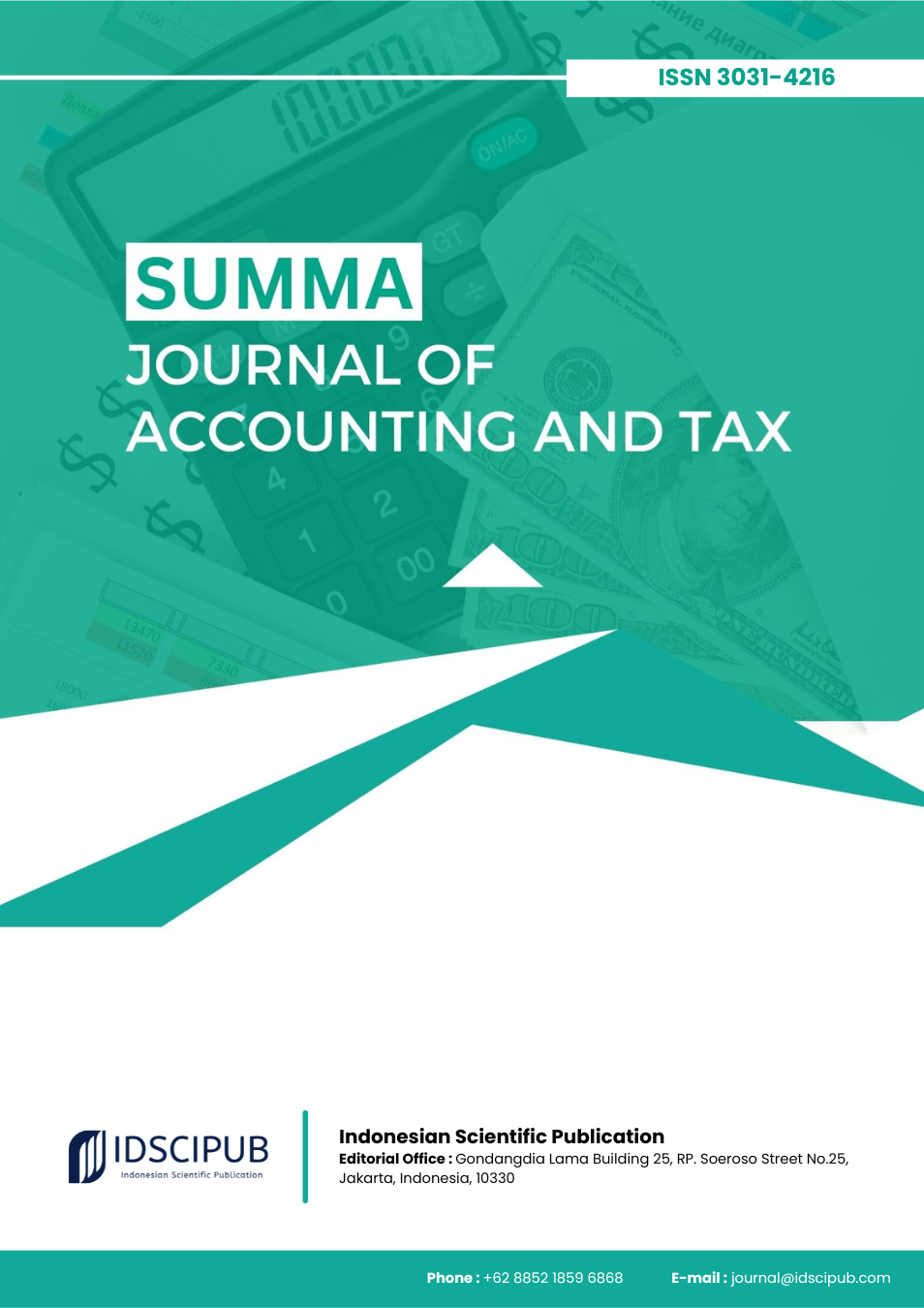Carbon Pricing Without the Tax: Investment Behavior Under Emerging Market Signals in Indonesia
DOI:
https://doi.org/10.61978/summa.v3i4.889Keywords:
Carbon Pricing, Emissions Trading, Green Investment, IDXCarbon, Indonesia, Policy Uncertainty, Internal Carbon PriceAbstract
Indonesia has adopted a hybrid carbon pricing strategy, combining a postponed carbon tax with operational instruments such as the Emissions Trading System (ETS) and the IDXCarbon exchange. This study examines whether these early pricing signals have already shaped firm-level investment behavior before the formal enforcement of the carbon tax. The methodology incorporates firm level variables such as ETS exposure, carbon intensity, and export dependence on the EU Carbon Border Adjustment Mechanism (CBAM), while controlling for financial indicators like profitability, size, and leverage. Key results indicate that firms with higher exposure to ETS and CBAM related markets significantly increased their environmental CapEx during the observed period. Event analysis reveals marked investment shifts following the launch of IDXCarbon and the government's carbon tax announcements. These findings suggest that Indonesian firms are responsive to carbon pricing signals even before full regulatory enforcement, especially when those signals are perceived as credible and market relevant. However, policy delays and uncertainty have moderated the pace and scale of investment responses. The discussion highlights the importance of internal carbon pricing, sectoral heterogeneity, governance dynamics, and comparisons with early phase ETS experiences in the EU, China, and Korea. The study concludes that clear and credible carbon pricing frameworks are essential for mobilizing private sector investment in sustainability. Indonesia must enhance the regulatory predictability and institutional strength of its carbon pricing system to fully realize its climate and investment objectives.
References
Ben‐Michael, E., Feller, A., & Stuart, E. A. (2021). A Trial Emulation Approach for Policy Evaluations With Group-Level Longitudinal Data. Epidemiology, 32(4), 533–540. https://doi.org/10.1097/ede.0000000000001369 DOI: https://doi.org/10.1097/EDE.0000000000001369
Berzaghi, F., Chami, R., Cosimano, T. F., & Fullenkamp, C. (2021). Valuation of Carbon Services Produced by Wild Animals Finances Conservation. https://doi.org/10.1101/2021.10.19.464992 DOI: https://doi.org/10.1101/2021.10.19.464992
Bhandari, M., Yadav, U., Dahal, T., & Karki, A. (2022). Depression, Anxiety and Stress Among Nurses Providing Care to the COVID-19 Patients: A Descriptive Cross-Sectional Study. Journal of Nepal Medical Association, 60(246), 151–154. https://doi.org/10.31729/jnma.7235 DOI: https://doi.org/10.31729/jnma.7235
Britz, W., & Arata, L. (2019). Econometric Mathematical Programming: An Application to the Estimation of Costs and Risk Preferences at Farm Level. Agricultural Economics, 50(2), 191–206. https://doi.org/10.1111/agec.12476 DOI: https://doi.org/10.1111/agec.12476
Bui, B., & Villiers, C. d. (2017). Business Strategies and Management Accounting in Response to Climate Change Risk Exposure and Regulatory Uncertainty. The British Accounting Review, 49(1), 4–24. https://doi.org/10.1016/j.bar.2016.10.006 DOI: https://doi.org/10.1016/j.bar.2016.10.006
Desai, R. (2023). Nexus Between Mandatory ESG Disclosure Regulation and Abnormal Stock Returns: A Study of an Emerging Economy. International Journal of Law and Management, 66(2), 236–258. https://doi.org/10.1108/ijlma-07-2023-0154 DOI: https://doi.org/10.1108/IJLMA-07-2023-0154
Dyarto, R., & Setyawan, D. (2020). Understanding the Political Challenges of Introducing a Carbon Tax in Indonesia. International Journal of Environmental Science and Technology, 18(6), 1479–1488. https://doi.org/10.1007/s13762-020-02925-4 DOI: https://doi.org/10.1007/s13762-020-02925-4
Fan, B., Zhang, Y., Li, X., & Miao, X. (2019). Trade Openness and Carbon Leakage: Empirical Evidence From China’s Industrial Sector. Energies, 12(6), 1101. https://doi.org/10.3390/en12061101 DOI: https://doi.org/10.3390/en12061101
Fan, J., & Shuangshuang, C. (2023). The Research on Decisions of Carbon Neutral Technology in a Retailer-Led Green Supply Chain Based on Cost Reduction and Carbon Trading. Academic Journal of Business & Management, 5(13). https://doi.org/10.25236/ajbm.2023.051302 DOI: https://doi.org/10.25236/AJBM.2023.051302
Firmansyah, A., & Medina, S. S. (2019). The Implementation of Accounting for Environmental Liabilities. Riset, 1(2), 121–133. https://doi.org/10.35212/riset.v1i2.20 DOI: https://doi.org/10.35212/riset.v1i2.20
Gambardella, C., Pahle, M., & Schill, W.-P. (2019). Do Benefits From Dynamic Tariffing Rise? Welfare Effects of Real-Time Retail Pricing Under Carbon Taxation and Variable Renewable Electricity Supply. Environmental and Resource Economics, 75(1), 183–213. https://doi.org/10.1007/s10640-019-00393-0 DOI: https://doi.org/10.1007/s10640-019-00393-0
Hartono, D., Indriyani, W., Iryani, B. S., Komarulzaman, A., Nugroho, A., & Kurniawan, R. (2023). Carbon Tax, Energy Policy, and Sustainable Development in Indonesia. Sustainable Development, 31(4), 2332–2346. https://doi.org/10.1002/sd.2511 DOI: https://doi.org/10.1002/sd.2511
Hsiang, S. (2016). Climate Econometrics. Annual Review of Resource Economics, 8(1), 43–75. https://doi.org/10.1146/annurev-resource-100815-095343 DOI: https://doi.org/10.1146/annurev-resource-100815-095343
Kanamura, T. (2022). Clean Energy and (E)SG Investing From Energy and Environmental Linkages. Environment Development and Sustainability, 25(9), 9779–9819. https://doi.org/10.1007/s10668-022-02460-x DOI: https://doi.org/10.1007/s10668-022-02460-x
Kandie, D., & Islam, K. J. (2021). A New Era of Microfinance: The Digital Microcredit and Its Impact on Poverty. Journal of International Development, 34(3), 469–492. https://doi.org/10.1002/jid.3607 DOI: https://doi.org/10.1002/jid.3607
Kolstad, C. D., & Moore, F. C. (2020). Estimating the Economic Impacts of Climate Change Using Weather Observations. Review of Environmental Economics and Policy, 14(1), 1–24. https://doi.org/10.1093/reep/rez024 DOI: https://doi.org/10.1093/reep/rez024
Lim, J., & Won, D. (2019). Impact of CARB’s Tailpipe Emission Standard Policy on CO2 Reduction Among the U.S. States. Sustainability, 11(4), 1202. https://doi.org/10.3390/su11041202 DOI: https://doi.org/10.3390/su11041202
Maryssa, H., Sabri, M., Fawwaz, A., Nasarudin, M., Hartini, A., & Azaimi, A. (2022). The Effect on Stock Price Inclusion or Exclusion From the Ftse4good Bursa Malaysia. Mar. https://doi.org/10.24191/mar.v21i03-04 DOI: https://doi.org/10.24191/MAR.V21i03-04
Ortiz, M., Cadarso, M., & Santiago, L. A. L. (2020). The Carbon Footprint of Foreign Multinationals Within the European Union. Journal of Industrial Ecology, 24(6), 1287–1299. https://doi.org/10.1111/jiec.13017 DOI: https://doi.org/10.1111/jiec.13017
Panjaitan, T. W. S., Dargusch, P., Aziz, A. A., & Wadley, D. (2018). Carbon Management in an Emissions-Intensive Industry in a Developing Economy: Cement Manufacturing in Indonesia. Case Studies in the Environment, 2(1), 1–9. https://doi.org/10.1525/cse.2017.000976 DOI: https://doi.org/10.1525/cse.2017.000976
Piluso, N. (2023). Why Should the Carbon Tax Be Floating? A Tobin’s Q Model Applied to Green Investment. Environmental Economics, 14(1), 81–90. https://doi.org/10.21511/ee.14(1).2023.08 DOI: https://doi.org/10.21511/ee.14(1).2023.08
Putri, S. K., & Arieftiara, D. (2023). Carbon Emission Disclosure, Media Exposure, Carbon Performance, and Firm Characteristics: Evidence From Indonesia. International Journal of Research in Business and Social Science (2147-4478), 12(3), 335–344. https://doi.org/10.20525/ijrbs.v12i3.2564 DOI: https://doi.org/10.20525/ijrbs.v12i3.2564
Roncalli, T., Guenedal, T. L., Lepetit, F., Roncalli, T., & Sekine, T. (2020). Measuring and Managing Carbon Risk in Investment Portfolios. https://doi.org/10.48550/arxiv.2008.13198 DOI: https://doi.org/10.2139/ssrn.3681266
Said, M. T., & ElBannan, M. A. (2023). Do ESG Ratings and COVID-19 Severity Score Predict Stock Behavior and Market Perception? Evidence From Emerging Markets. Review of Accounting and Finance, 23(2), 222–255. https://doi.org/10.1108/raf-03-2023-0083 DOI: https://doi.org/10.1108/RAF-03-2023-0083
Seto, K. C., Davis, S. J., Mitchell, R. B., Stokes, E. C., Unruh, G. C., & Ürge-Vorsatz, D. (2016). Carbon Lock-In: Types, Causes, and Policy Implications. Annual Review of Environment and Resources, 41(1), 425–452. https://doi.org/10.1146/annurev-environ-110615-085934 DOI: https://doi.org/10.1146/annurev-environ-110615-085934
Tiwari, A. K., Jena, S. K., Kumar, S., & Hille, E. (2021). Is Oil Price Risk Systemic to Sectoral Equity Markets of an Oil Importing Country? Evidence From a Dependence-Switching Copula Delta CoVaR Approach. Annals of Operations Research, 315(1), 429–461. https://doi.org/10.1007/s10479-021-04218-6 DOI: https://doi.org/10.1007/s10479-021-04218-6
Wan-li, M. (2023). A Comparative Study of Carbon Pricing Policies in China and the Scandinavian Countries: Lessons for Effective Climate Change Mitigation With a Focus on Sweden. E3s Web of Conferences, 424, 04005. https://doi.org/10.1051/e3sconf/202342404005 DOI: https://doi.org/10.1051/e3sconf/202342404005
Zhang, Y., & Tressel, T. (2017). Effectiveness and Channels of Macroprudential Policies: Lessons From the Euro Area. Journal of Financial Regulation and Compliance, 25(3), 271–306. https://doi.org/10.1108/jfrc-10-2016-0094 DOI: https://doi.org/10.1108/JFRC-10-2016-0094
Zou, X., Shi-heng, Y., Ibrahim, R. L., & Al‐Faryan, M. A. S. (2023). Probing the Environmental Impacts of Structural Transition and Demographic Mobility in Africa: Does Technological Innovation Matter? Energy & Environment, 35(5), 2699–2725. https://doi.org/10.1177/0958305x231153967 DOI: https://doi.org/10.1177/0958305X231153967







